Submitted:
29 August 2024
Posted:
29 August 2024
You are already at the latest version
Abstract
Keywords:
1. Introduction
2. Materials and Methods
2.1. Site Description
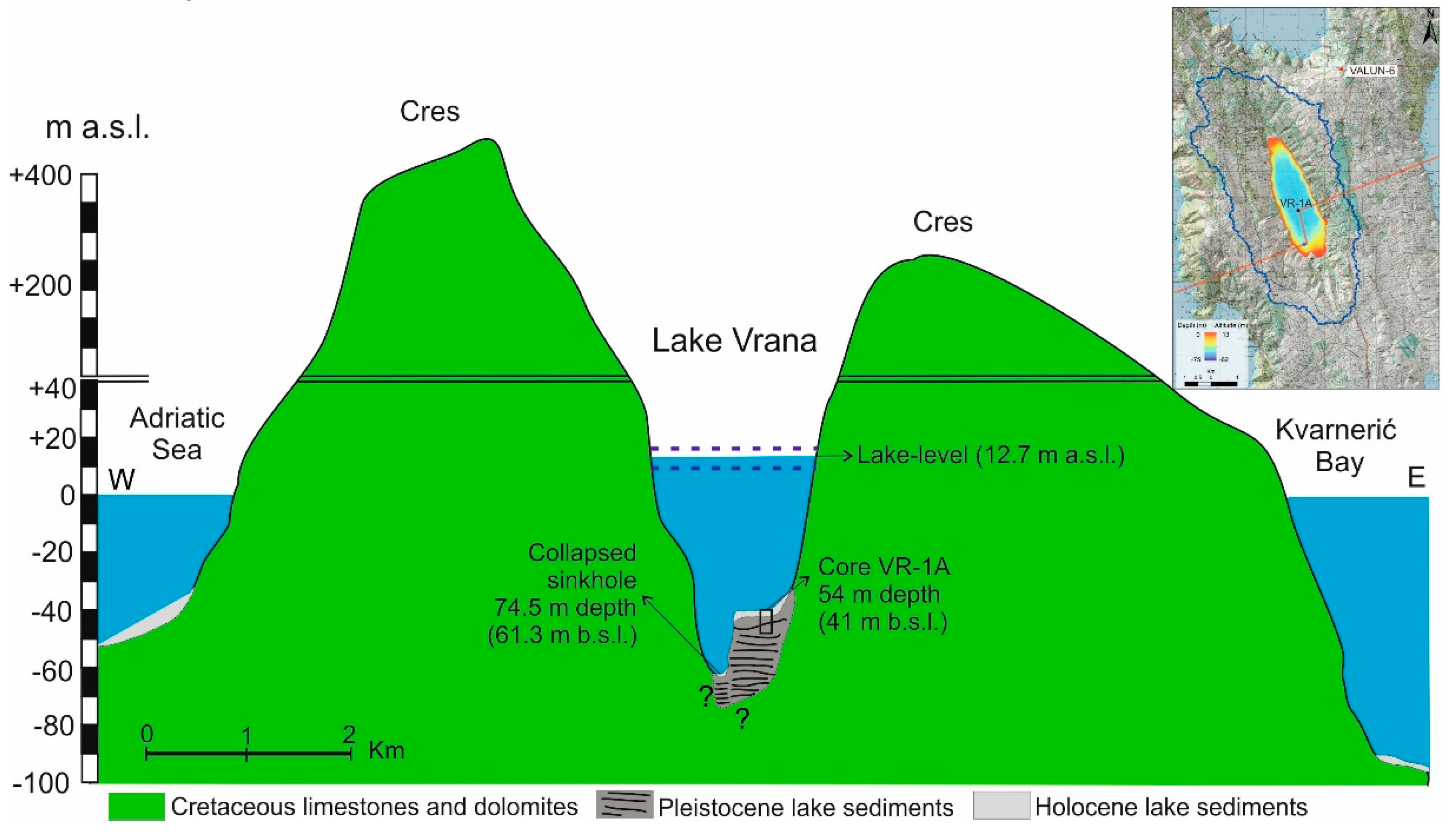
2.2. Sediment Sampling
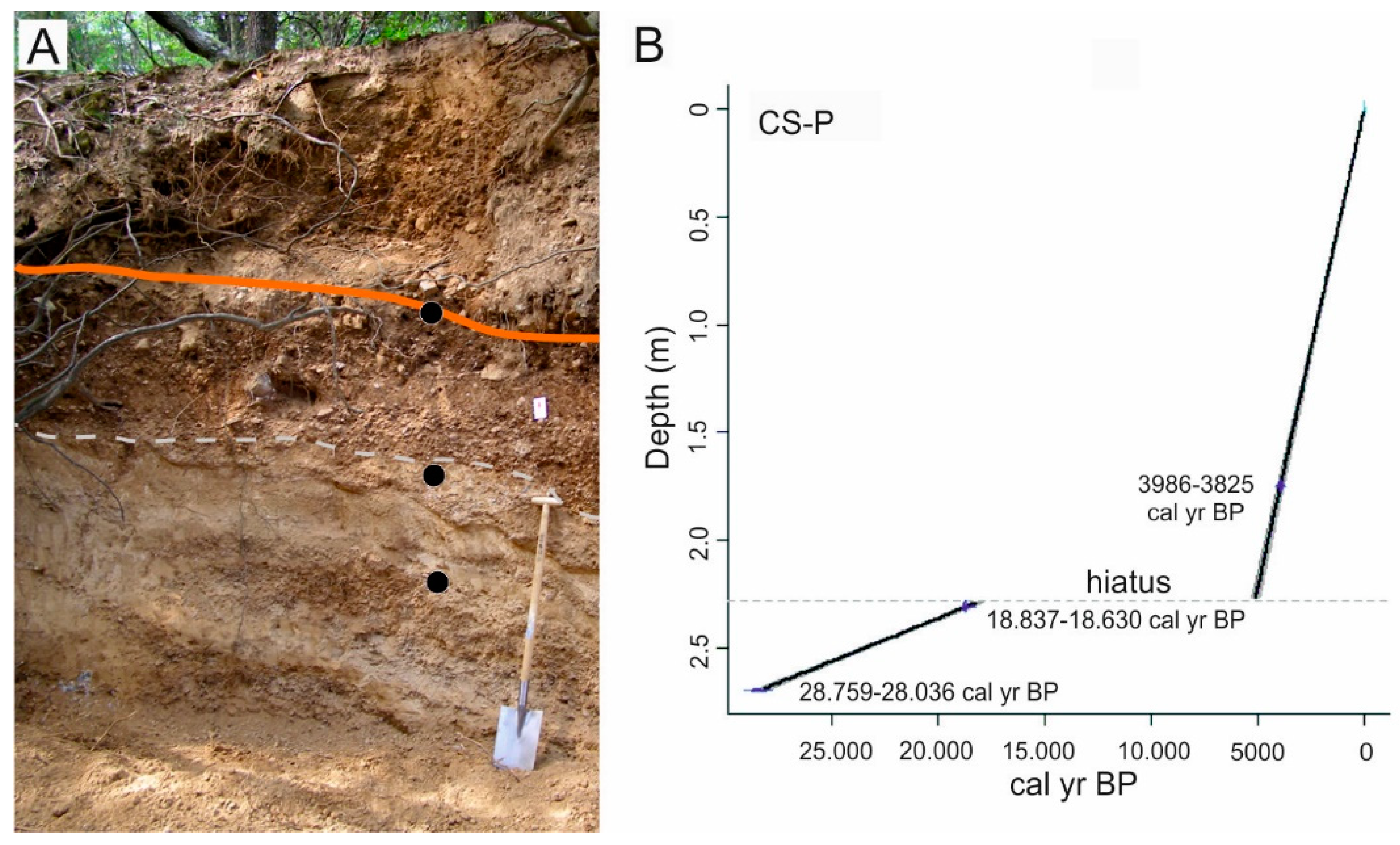
2.3. Laboratory Analyses
2.3.1. Sedimentological Analyses (Sediment Lightness, Magnetic Susceptibility and Grain Size)
2.3.2. Mineralogical Analyses
2.3.3. Geochemical Analyses
2.3.4. Radiocarbon Dating
3. Results
3.1. Sedimentation Rates
3.2. Sedimentological, Mineralogical and Geochemical Description of Sediment Cores VR-1A, CS-5, CS-9 and Profile CS-P
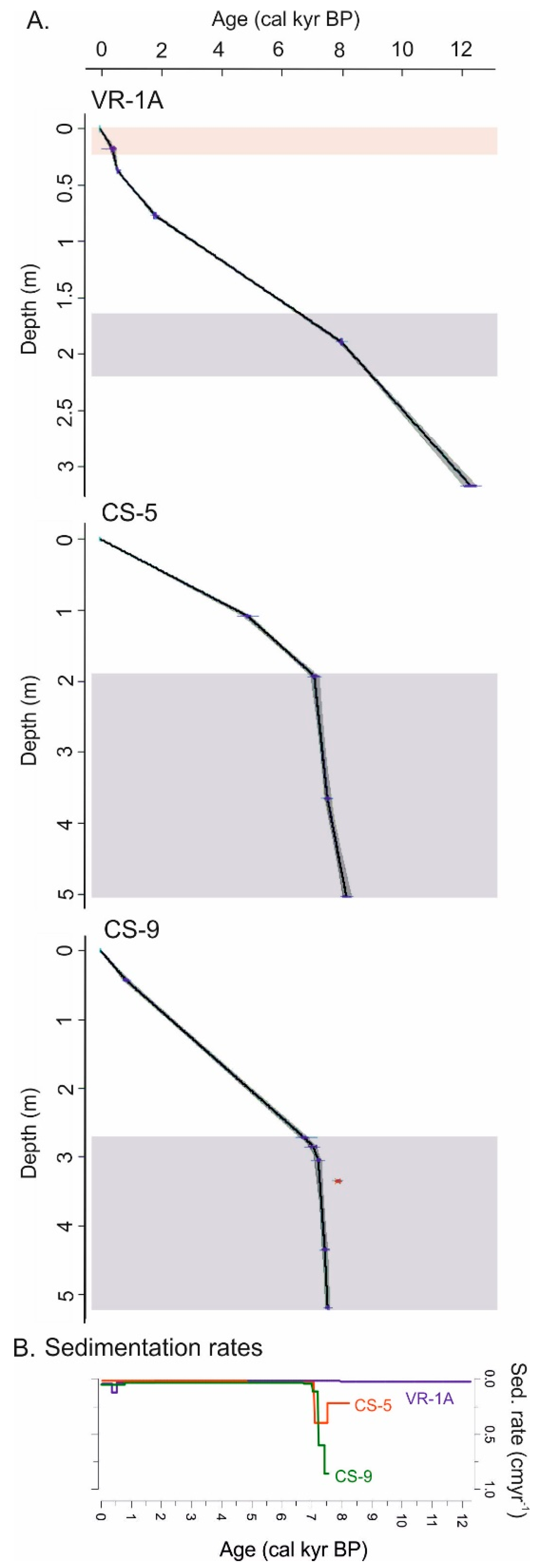

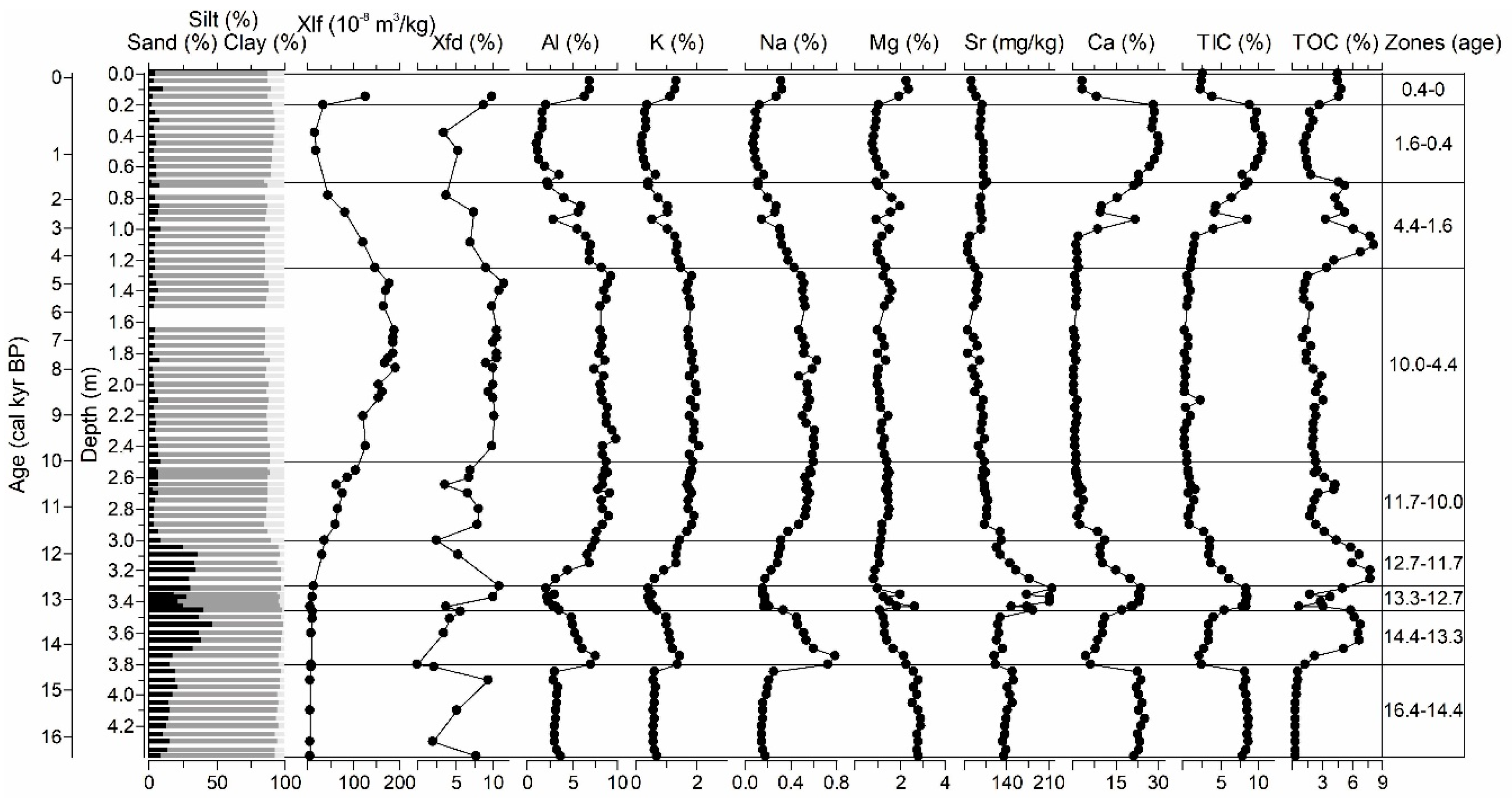
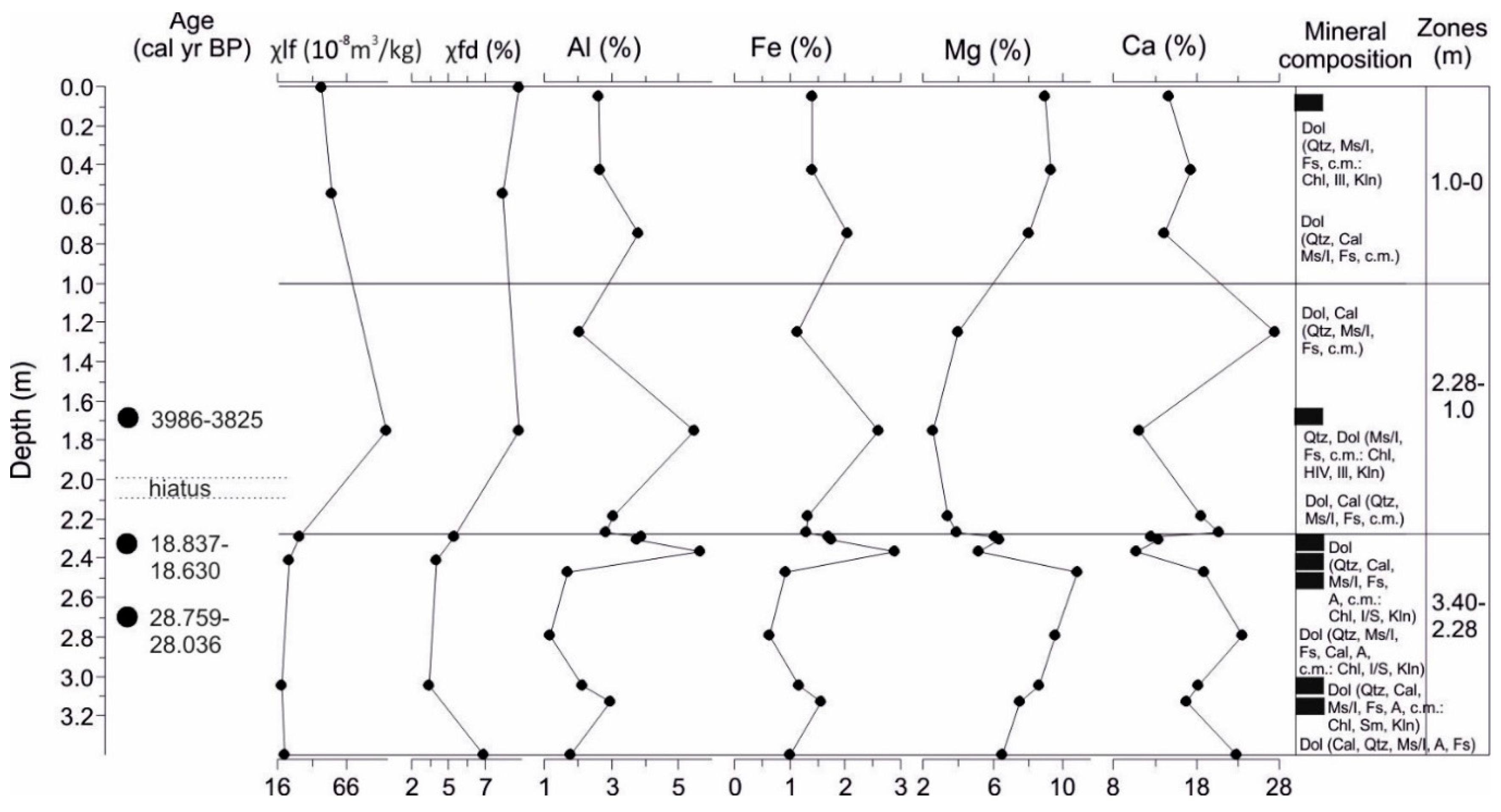
4. Discussion
4.1. Environmental Interpretation of Geochemical and Mineralogical Data and Paleoenvironmental Reconstruction
4.1.1. Late Pleistocene (Base of the Core VR-1A: 7.37-7.18 m)
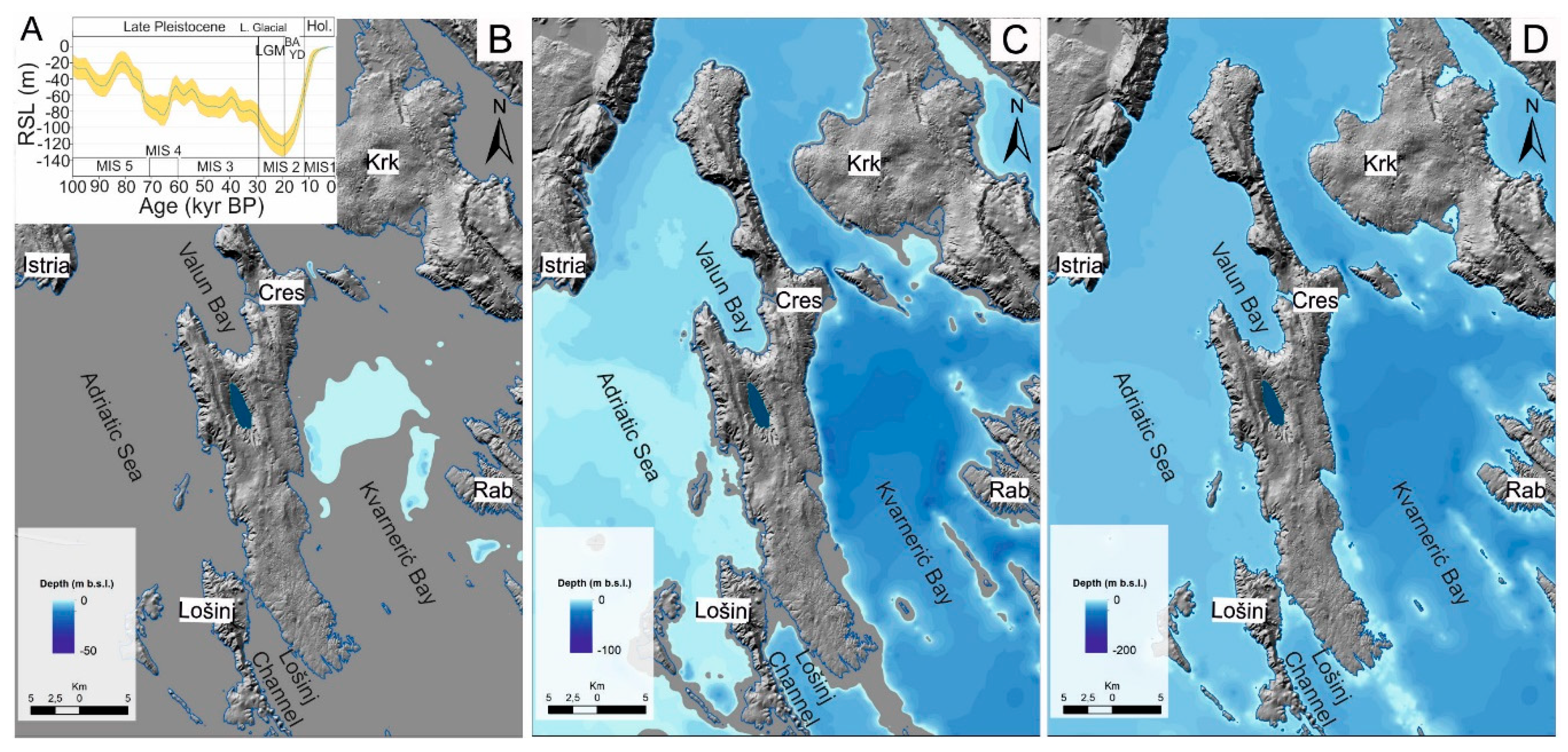
4.1.2. Late Glacial to Holocene Transition (16.4-11.7 cal kyr BP; Zones 1 to 4)
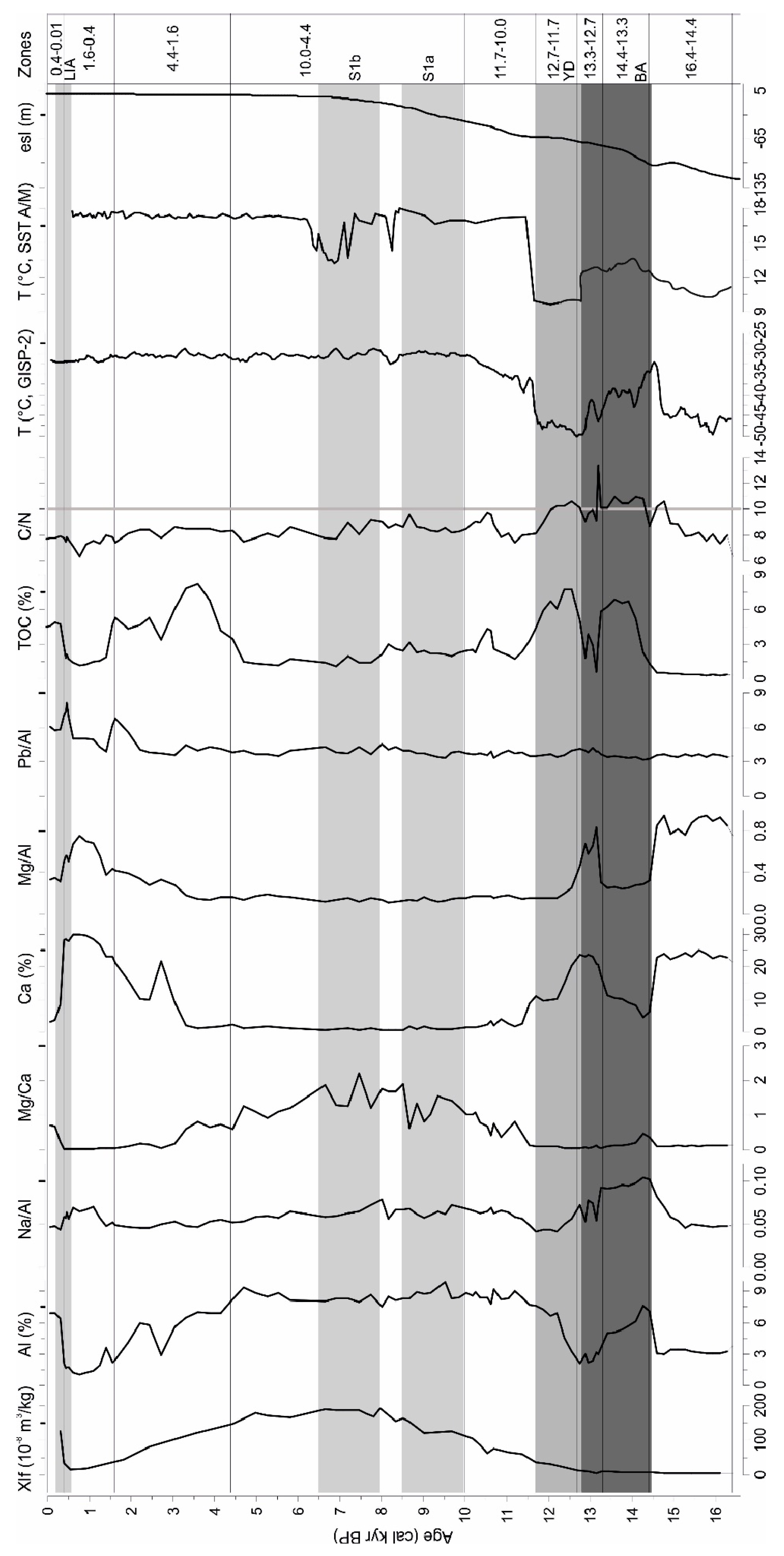
4.1.3. Early to Middle Holocene (11.7-4.4 cal kyr BP; Zones 5 and 6)
4.1.4. Late Holocene (4.4 cal kyr BP to Present; Zones 7 to 10)
4.2. Deciphering Sediment Source for Lake Vrana Sediments
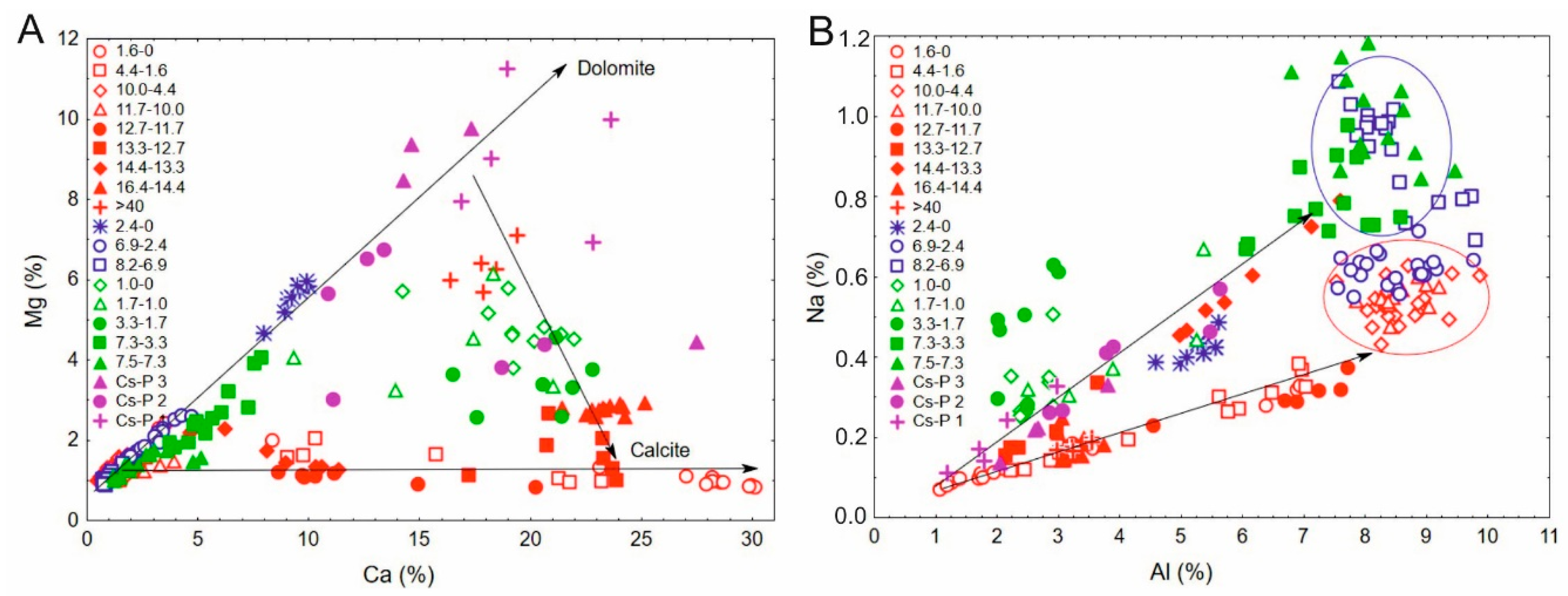
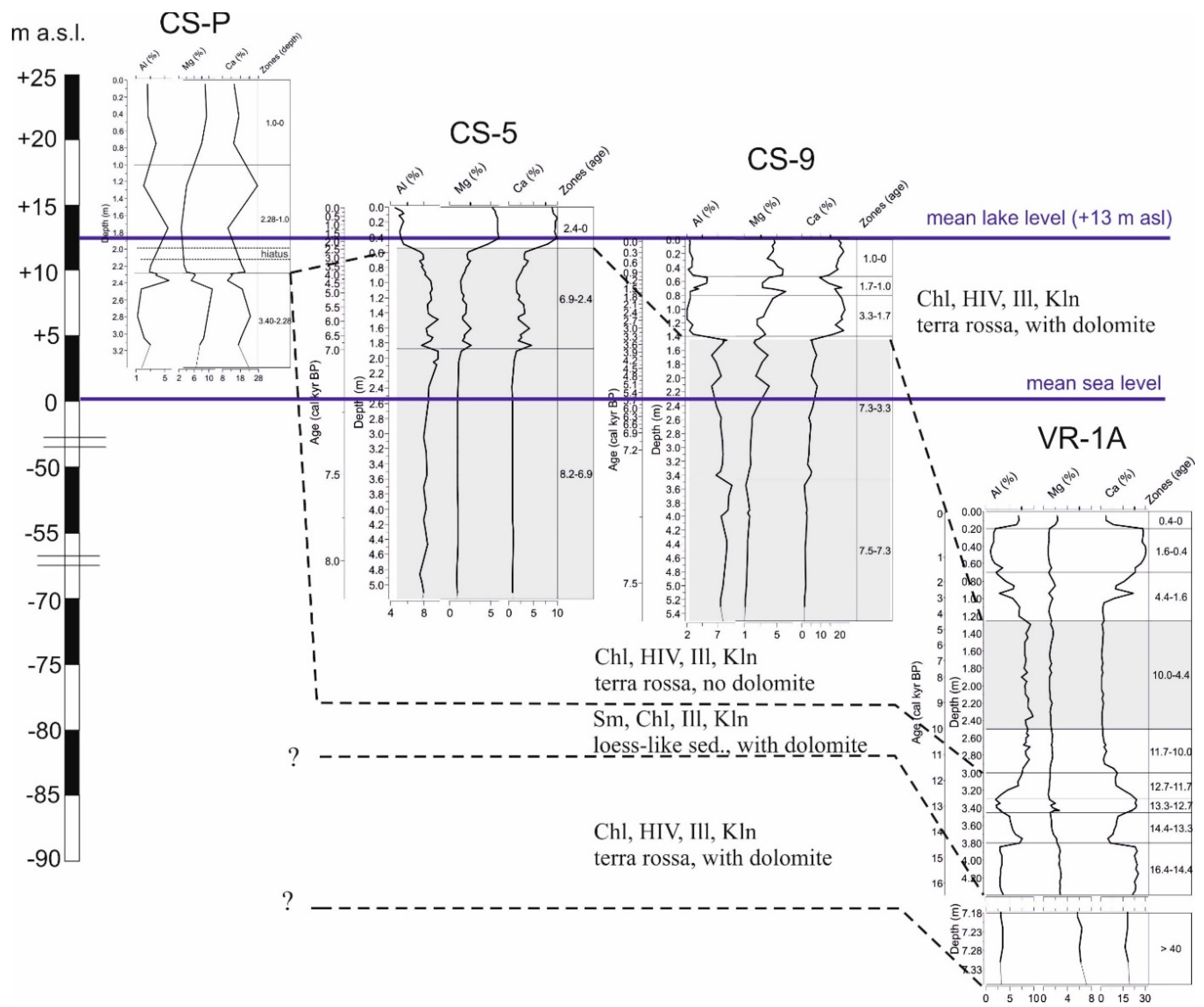
5. Conclusions
Supplementary Materials
Author Contributions
Funding
Data Availability Statement
Acknowledgments
Conflicts of Interest
References
- Roberts, N.; Jones, M.D.; Benkaddour, A.; Eastwood, W.J.; Filippi, M.L.; Frogley, M.R.; Lamb, H.F.; Leng, M.J.; Reed, J.M.; Stein, M.; Stevens, L.; Valero-Garcés, B.; Zanchetta, G. Stable Isotope Records of Late Quaternary Climate and Hydrology from Mediterranean Lakes: The ISOMED Synthesis. Quat. Sci. Rev. 2008, 27, 2426–2441. [Google Scholar] [CrossRef]
- Kuhta, M.; Brkić, Ž. Seasonal Temperature Variations of Lake Vrana on the Island of Cres and Possible Influence of Global Climate Changes. J. Earth Sci. Eng. 2013, 4, 225–237. [Google Scholar]
- Brkić, Ž. Increasing water temperature of the largest freshwater lake on the Mediterranean islands as an indicator of global warming. Heliyon 2023, 9, e19248. [Google Scholar] [CrossRef]
- Hrnjica, B.; Bonacci, O. Lake Level Prediction using Feed Forward and Recurrent Neural Networks. Water Resour. Manage. 2019, 33, 2471–2484. [Google Scholar] [CrossRef]
- Last, W.M.; Smol, J.P. An Introduction to Physical and Geochemical Methods Used in Paleolimnology. In Tracking Environmental Change Using Lake Sediments; Last, W.M., Smol, J.P., Eds.; Kluwer Academic Publishers: Dordrecht, 2001; pp. 1–5. [Google Scholar] [CrossRef]
- Håkanson, L.; Jansson, M. Principles of lake sedimentology. The Blackburn Press: USA, 2002. [Google Scholar]
- Schmidt, R.; Müller, J.; Drescher-Schneider, R.; Krisai, R.; Szeroczyńska, K.; Barić, A. Changes in Lake Level and Trophy at Lake Vrana, a Large Karstic Lake on the Island of Cres (Croatia), with Respect to Palaeoclimate and Anthropogenic Impacts during the Last Approx. 16,000 Years. J. Limnol. 2000, 59, 113. [Google Scholar] [CrossRef]
- Bakrač, K.; Ilijanić, N.; Miko, S.; Hasan, O. Evidence of Sapropel S1 Formation from Holocene Lacustrine Sequences in Lake Vrana in Dalmatia (Croatia). Quat. Int. 2018, 494, 5–18. [Google Scholar] [CrossRef]
- Caput Mihalić, K.; Galović, I.; Ilijanić, N.; Hasan, O.; Ledinski, M.; Miko, S.; Mesić, S. Evidence of lake-level fluctuations during the late Holocene based on diatoms from Lake Vransko, Cres Island (north-central Mediterranean). Quat. Int. 2024, in press. [Google Scholar] [CrossRef]
- Galović, I.; Caput Mihalić, K.; Ilijanić, N.; Miko, S.; Hasan, O. Diatom Responses to Holocene Environmental Changes in a Karstic Lake Vrana in Dalmatia (Croatia). Quaternary International 2018, 67–179. [Google Scholar] [CrossRef]
- Hajek-Tadesse, V.; Ilijanić, N.; Miko, S.; Hasan, O. Holocene Ostracoda (Crustacea) from the Shallow Lake Vrana (Dalmatia, Croatia) and Their Paleoenvironmental Significance. Quat. Int. 2018, 494, 80–91. [Google Scholar] [CrossRef]
- Ilijanić, N.; Miko, S.; Ivkić Filipović, I.; Hasan, O.; Šparica Miko, M.; Petrinec, B.; Terzić, J.; Marković, T. A Holocene Sedimentary Record and the Impact of Sea-Level rise in the Karst Lake Velo Blato and the Wetlands on Pag Island (Croatia). Water 2022, 14, 342. [Google Scholar] [CrossRef]
- Balbo, A.L.; Andrič, M.; Rubinić, J.; Moscariello, A.; Miracle, P.T. Palaeoenvironmental and archaeological implications of a sediment core from Polje Čepić, Istria, Croatia. Geol. Croat. 2006, 59/2, 109–124. [Google Scholar] [CrossRef]
- Ilijanić, N.; Miko, S.; Hasan, O.; Bakrač, K. Holocene Environmental Record from Lake Sediments in the Bokanjačko Blato Karst Polje (Dalmatia, Croatia). Quat. Int. 2018, 494, 66–79. [Google Scholar] [CrossRef]
- Schmidt, R.; Pugliese, N.; Müller, J.; Szeroczyriska, K.; Bogner, D.; Melis, R.; Kamenik, C.; Bari, A.; Danielopol, D.L. Palaeoclimate, vegetation and coastal lake development, from the Pleniglacial until early Holocene, in the northern Adriatic Valun bay (Isle of Cres, Croatia). J. Quat. Sci. 2001, 14, 61–78. [Google Scholar]
- Brunović, D.; Miko, S.; Hasan, O.; Papatheodorou, G.; Ilijanić, N.; Miserocchi, S.; Correggiari, A.; Geraga, M. Late Pleistocene and Holocene Paleoenvironmental Reconstruction of a Drowned Karst Isolation Basin (Lošinj Channel, NE Adriatic Sea). Palaeogeogr. Palaeoclimatol. Palaeoecol. 2020, 544. [Google Scholar] [CrossRef]
- Brunović, D.; Hasan, O.; Miko, S.; Georgiou, N.; Geraga, M.; Christodoulou, D.; Dimas, X.; Ilijanić, N.; Papatheodorou, G. High-resolution seismic record of the Quaternary palaeoenvironments along a Dalmatian-type coast (Lošinj Channel, Adriatic Sea). Mar. Geol. 2024, 474, 107325. [Google Scholar] [CrossRef]
- Šolaja, D.; Miko, S.; Brunović, D.; Ilijanić, N.; Hasan, O.; Papatheodorou, G.; Geraga, M.; Durn, T.; Christodoulou, D.; Razum, I. Late Quaternary Evolution of a Submerged Karst Basin Influenced by active Tectonics (Koločep Bay, Croatia). J. Mar. Sci. Eng. 2022, 10, 881. [Google Scholar] [CrossRef]
- Jahns, S.; Bogaard, C. New palynological and tephrostratigraphical investigations of two salt lagoons on the island of Mljet, south Dalmatia, Croatia. Veg. Hist. Archaeobotany 1998, 7, 219–234. [Google Scholar] [CrossRef]
- Wunsam, S.; Schmidt, R.; Müller, J. Holocene Lake Development of Two Dalmatian Lagoons (Malo and Veliko Jezero, Isle of Mljet) in Respect to Changes in Adriatic Sea Level and Climate. Palaeogeogr. Palaeoclimatol. Palaeoecol. 1999, 146, 251–281. [Google Scholar] [CrossRef]
- Razum, I.; Miko, S.; Ilijanić, N.; Hasan, O.; Šparica Miko, M.; Brunović, D.; Pawlowsky-Glahn, V. A Compositional Approach to the Reconstruction of Geochemical Processes Involved in the Evolution of Holocene Marine Flooded Coastal Karst Basins (Mljet Island, Croatia). Appl. Geochemistry 2020, 116, 104574. [Google Scholar] [CrossRef]
- Razum, I.; Miko, S.; Ilijanić, N.; Petrelli, M.; Röhl, U.; Hasan, O.; Giaccio, B. Holocene Tephra Record of Lake Veliko Jezero, Croatia: Implications for the Central Mediterranean Tephrostratigraphy and Sea Level Rise. Boreas 2020, 49, 653–673. [Google Scholar] [CrossRef]
- Razum, I.; Bajo, P.; Brunović, D.; Ilijanić, N.; Hasan, O.; Röhl, U.; Miko, M.Š.; Miko, S. Past Climate Variations Recorded in Needle-like Aragonites Correlate with Organic Carbon Burial Efficiency as Revealed by Lake Sediments in Croatia. Sci. Rep. 2021, 11, 7568. [Google Scholar] [CrossRef]
- Hasan, O.; Miko, S.; Brunović, D.; Papatheodorou, G.; Christodolou, D.; Ilijanić, N.; Geraga, M. Geomorphology of Canyon Outlets in Zrmanja River Estuary and Its Effect on the Holocene Flooding of Semi-Enclosed Basins (the Novigrad and Karin Seas, Eastern Adriatic). Water 2020, 12, 2807. [Google Scholar] [CrossRef]
- Hasan, O.; Smrkulj, N.; Miko, S.; Brunović, D.; Ilijanić, N.; Šparica Miko, M. Integrated Reconstruction of late Quaternary Geomorphology and Sediment Dynamics of Prokljan Lake and Krka River Estuary, Croatia. Remote Sens. 2023, 15, 2588. [Google Scholar] [CrossRef]
- Smrkulj, N.; Hasan, O.; Brunović, D.; Miko, S.; Ilijanić, N. Holocene palaeoenvironmental development of Prokljan Lake (Krka River, Croatia): Evolution from a calcareous tufa barrier system to a karst estuary. Mar. Geol. 2024, 476, 107370. [Google Scholar] [CrossRef]
- Ford, D.; Williams, P. Karst Hydrogeology and Geomorphology. John Wiley & Sons Ltd.: Chichester, UK, 2007. [Google Scholar]
- Miko, S.; Mesić, S.; Prohić, E.; Peh, Z. Trace element distribution in surface sediments of Lake Vrana and topsoil of Cres island, Croatia. Natura Croatica. 2003, 12/2, 93–111. [Google Scholar]
- Miko, S.; Mesić, S.; Šparica Miko, M.; Hasan, O. A record of anthropogenic Pb deposition in a Mediterranean karst catchment (Lake Vrana, Cres Island, Croatia). Mineralogical Magazine 2008, 72/1, 455–460. [Google Scholar] [CrossRef]
- Waelbroeck, C.; Labeyrie, L.; Michel, E.; Duplessy, J.C.; McManus, J.F.; Lambeck, K.; Balbon, E.; Labracherie, M. Sea-level and deep water temperature changes derived from benthic foraminifera isotopic records. Quat. Sci. Rev. 2002, 21, 295–305. [Google Scholar] [CrossRef]
- Lambeck, K.; Rouby, H.; Purcell, A.; Sun, Y.; Sambridge, M. Sea Level and Global Ice Volumes from the Last Glacial Maximum to the Holocene. Proc. Natl. Acad. Sci. 2014, 111, 15296–15303. [Google Scholar] [CrossRef] [PubMed]
- Benjamin, J.; Rovere, A.; Fontana, A.; Furlani, S.; Vacchi, M.; Inglis, R.H.; Galili, E.; Antonioli, F.; Sivan, D.; Miko, S.; Mourtzas, N.; Felja, I.; Meredith-Williams, M.; Goodman-Tchernov, B.; Kolaiti, E.; Anzidei, M.; Gehrels, R. Late Quaternary Sea-Level Changes and Early Human Societies in the Central and Eastern Mediterranean Basin: An Interdisciplinary Review. Quat. Int. 2017, 449, 29–57. [Google Scholar] [CrossRef]
- Pikelj, K.; Juračić, M. Eastern Adriatic Coast (EAC): Geomorphology and Coastal Vulnerability of a Karstic Coast. J. Coast. Res. 2013, 289, 944–957. [Google Scholar] [CrossRef]
- Leder, T.D.; Ujević, T.; Čala, M. Coastline Lenghts and Areas of Islands in the Croatian Part of the Adriatic Sea Determined from the Topographic Maps at the Scale of 1:25,000. Geoadria 2017, 9, 5–32. [Google Scholar] [CrossRef]
- Brkić, Ž.; Kuhta, M. Lake level evolution of the largest freshwater lake on the Mediterranean islands through drought analysis and machine learning. Sustainability 2022, 14, 10447. [Google Scholar] [CrossRef]
- Fuček, L.; Matičec, D.; Vlahović, I.; Oštrić, N.; Prtoljan, B.; Korbar, T.; Husinec, A.; Palenik, D. Basic Geological Map of the Republic of Croatia Scale 1:50.000 - Sheet Cres 4. Croatian Geological Survey: Zagreb, 2014. [Google Scholar]
- Korbar, T. Orogenic evolution of the External Dinarides in the NE Adriatic region: a model constrained by tectonostratigraphy of Upper Cretaceous to Palaeogene carbonates. Earth-Sci. Rev. 2009, 96, 296–312. [Google Scholar] [CrossRef]
- Vlahović, I.; Tišljar, J.; Velić, I.; Matičec, D. Evolution of the Adriatic Carbonate Platform: Palaeogeography, Main Events and Depositional Dynamics. Palaeogeogr. Palaeoclimatol. Palaeoecol. 2005, 220, 333–360. [Google Scholar] [CrossRef]
- Bonacci, O. The Vrana Lake Hidrology (Island of Cres-Croatia). Journal of the American Water Resources Association 1993, 29/3, 407–417. [Google Scholar] [CrossRef]
- Hertelendi, E.; Svingor, E.; Futo, I.; Szanto, Z.; Rank, D. Isotope Investigation of Lake Vrana and Springs in the Kvarner Area. Rapid Communication in Mass Spectrometry 1997, 11, 651–655. [Google Scholar] [CrossRef]
- Brkić, Ž.; Larva, O. Impact of climate change on the Vrana Lake surface water temperature in Croatia using support vector regression. Journal of Hydrology: Regional Studies 2024, 54, 101858. [Google Scholar] [CrossRef]
- Ožanić, N. Hydrological Functioning Model of the Vrana Lake on the Cres Island. Ph.D. Thesis, University of Split, Split, Croatia, 1996. (In Croatian). [Google Scholar]
- Koeck, R. CC-WaterS Monograph: Climate Change and Impact on Water Supply. Vienna, 2012. [Google Scholar]
- Gligora Udovič, M.; Žutinić, P.; Kralj Borojević, K.; Plenković-Moraj, A. Co-occurrence of functional groups in phytoplankton assemblages dominated by diatoms, chrysophytes and dinoflagellates. Fundamental and Applied Limnology 2015, 187, 101–111. [Google Scholar] [CrossRef]
- Gligora Udovič, M.; Cvetkoska, A.; Žutinić, P.; Bosak, S.; Stanković, I.; Špoljarić, I.; Mršić, G.; Kralj Borojević, K.; Čukurin, A.; Plenković-Moraj, A. Defining centric diatoms of most relevant phytoplankton functional groups in deep karst lakes. Hydrobiologia 2017, 78, 169–191. [Google Scholar] [CrossRef]
- Golubić, S. Prethodna istraživanja vegetacije jezera Vrana na otoku Cresu. Ljetopis JAZU, 1961. Book 65, Zagreb, 295-297.
- Alegro, A.; Stanković, I.; Šegota, V.; Van de Weyer, K.; Blaženčić, J. Macrophytic vegetation in the oligotrophic Mediterranean Lake Vrana (Island of Cres, Northern Adriatic)—New insight after 50 years. Botanica Serbica 2016, 40, 137144. [Google Scholar]
- Blott, S.J.; Pye, K. GRADISTAT: A Grain Size Distribution and Statistics Package for the Analysis of Unconsolidated Sediments. Earth Surf. Process. Landforms 2001, 26, 1237–1248. [Google Scholar] [CrossRef]
- Juggins, S. C2 data analysis, version 1.7.4., software for ecological and palaeooecological dana analysis and visualisation. Newcastle University: Newcastle upon Tyne, UK, 2011. [Google Scholar]
- Brindley, G.W.; Brown, G. Crystal structures of clay minerals and their X-ray identification. Mineralogical Society: London, 1980. [Google Scholar]
- Moore, D.M.; Reynolds, R.C. X-Ray Diffraction and the Identification and Analysis of Clay Minerals, 2nd ed.; Oxford University Press: Oxford, 1997. [Google Scholar]
- Döbelin, N. Profex, version 3.0.0. RMS Foundation: Bettlach, Switzerland, 2013. [Google Scholar]
- Van der Weijden, C.H. Pitfalls of normalization of marine geochemical data using a common divisor. Mar. Geol. 2002, 184/3-4, 167–187. [Google Scholar] [CrossRef]
- StatSoft, Inc. STATISTICA (Data Analysis Software System), Version 7.1. 2016. www.739statsoft.com2006.
- Reimer, P.; Austin, W.; Bard, E.; Bayliss, A.; Blackwell, P.; Bronk Ramsey, C.; Butzin, M.; Cheng, H.; Edwards, R.; Friedrich, M.; Grootes, P.; Guilderson, T.; Hajdas, I.; Heaton, T.; Hogg, A.; Hughen, K.; Kromer, B.; Manning, S.; Muscheler, R.; Palmer, J.; Pearson, C.; van der Plicht, J.; Reimer, R.; Richards, D.; Scott, E.; Southon, J.; Turney, C.; Wacker, L.; Adolphi, F.; Büntgen, U.; Capano, M.; Fahrni, S.; Fogtmann-Schulz, A.; Friedrich, R.; Köhler, P.; Kudsk, S.; Miyake, F.; Olsen, J.; Reinig, F.; Sakamoto, M.; Sookdeo, A.; Talamo, S. The IntCal20 Northern Hemisphere radiocarbon age calibration curve (0–55 cal kBP). Radiocarbon 2020, 62. [Google Scholar] [CrossRef]
- Blaauw, M. Methods and code for 'classical' age-modelling of radiocarbon sequences. Quaternary Geochronology 2010, 5, 512–518. [Google Scholar] [CrossRef]
- Balsam, W.L.; Deaton, B.C.; Damuth, J.E. Evaluating optical lightness as a proxy for carbonate content in marine sediment cores. Marine Geology 1999, 161, 141–153. [Google Scholar] [CrossRef]
- Maher, B.A.; Thompson, R. Quaternary Climates, Environments and Magetism. Cambridge University Press, 1999. [Google Scholar]
- Antonioli, F.; Ferranti, L.; Fontana, A.; Amorosi, A.; Bondesan, A.; Braitenberg, C.; Dutton, A.; Fontolan, G.; Furlani, S.; Lambeck, K.; Mastronuzzi, G.; Monaco, C.; Spada, G.; Stocchi, P. Holocene relative sea-level changes and vertical movements along the Italian and Istrian coastlines. Quat. Int. 2009, 206, 102–133. [Google Scholar] [CrossRef]
- Maselli, V.; Hutton, E.W.; Kettner, A.J.; Syvitski, J.P.M.; Trincardi, F. Highfrequency Sea level and sediment supply fluctuations during termination I: an integrated sequence-stratigraphy and modeling approach from the Adriatic Sea (Central Mediterranean). Mar. Geol. 2011, 287, 54–70. [Google Scholar] [CrossRef]
- Maselli, V.; Trincardi, F. Large-scale single incised valley from a small catchment basin on the western Adriatic margin (Central Mediterranean Sea). Glob. Planet. Chang. 2013, 100, 245–262. [Google Scholar] [CrossRef]
- Razum, I.; Hasan, O.; Brunović, D.; Schulz, H.; Ilijanić, N.; Beg Paklar, G.; Ramisch, A.; Giaccio, B.; Šparica Miko, M.; Monaco, L.; Miko, S. Influence of changing water mass circulation on detrital component and carbon burial of late Pleistocene and Holocene sediments in the eastern-central Mid-Adriatic deep. Marine and Petroleum Geology 2024, 167, 106985. [Google Scholar] [CrossRef]
- Ilijanić, N. Clay minerals in lake sediments along the eastern Adriatic coast as proxies of environmental changes during Late Pleistocene and Holocene. Ph.D. Thesis, Faculty of Science, University of Zagreb, Zagreb, Croatia, 2014. (In Croatian). [Google Scholar]
- Siani, G.; Paterne, M.; Colin, C. Late glacial to Holocene planktic foraminifera bioevents and climatic record in the South Adriatic Sea. J. Quat. Sci. 2010, 25, 808–821. [Google Scholar] [CrossRef]
- Alley, R.B. Ice-core evidence of abrupt climate changes. Proceedings of the National Academy of Sciences 2000, 97, 1331–1334. [Google Scholar] [CrossRef]
- Meyers, P.A.; Teranes, J.L. Sediment Organic Matter. In Tracking Environmental Change Using Lake Sediments Vol 2: Physical and Geochemical Methods; Last, W.M., Smol, J.P., Eds.; Kluwer Academic Publisher: Dordrecht, 2001; pp. 239–269. [Google Scholar] [CrossRef]
- Dormoy, I.; Peyron, O.; Combourieu-Neboutb, N.; Goring, S.; Kotthoff, U.; Magny, M.; Pross, J. Terrestrial climate variability and seasonality changes in the Mediterranean region between 15 000 and 4000 years BP deduced from marine pollen records. Climate of the Past 2009, 5, 615–632. [Google Scholar] [CrossRef]
- Strasser, M.; Anselmetti, F.S.; Fäh, D.; Giardini, D.; Schnellmann, M. Magnitudes and source areas of large prehistoric northern Alpine earthquakes revealed by slope failures in lakes. Geology 2006, 34, 1005–1008. [Google Scholar] [CrossRef]
- Strasser, M.; Monecke, K.; Schnellmann, M.; Anselmetti, F. Lake sediments as natural seismographs: a compiled record of Late Quaternary earthquakes in Central Switzerland and its implication for Alpine deformation. Sedimentology 2013, 60, 319–341. [Google Scholar] [CrossRef]
- Hartman, G.; Bar-Yosef, O.; Brittingham, A.; Grosman, L.; Munro, N.D. Hunted gazelles evidence cooling, but not drying, during the Younger Dryas in the southern Levant. Proc. Natl. Acad. Sci. U.S.A. 2016, 113, 3997–4002. [Google Scholar] [CrossRef] [PubMed]
- Bout-Roumazeilles, V.; Combourieu-Nebout, N.; Desprat, S.; Siani, G.; Turon, J.L.; Essallami, L. Tracking atmospheric and riverine terrigenous supplies variability during the last glacial and the Holocene in central Mediterranean. Clim. Past. 2013, 9, 1065–1087. [Google Scholar] [CrossRef]
- Lugović, B.; Majer, V. Eruptivi Senjske drage (Vratnika) kod Senja (Hrvatska, Jugoslavija). Geološki vjesnik 1983, 36, 157–181. [Google Scholar]
- Mercone, D.; Thomson, J.; Croudace, I.W.; Siani, G.; Paterne, M.; Troelstra, S. Duration of S1, the most recent sapropel in the eastern Mediterranean Sea, as indicated by accelerator mass spectrometry radiocarbon and geochemical evidence. Paleoceanography 2000, 15, 336–347. [Google Scholar] [CrossRef]
- Tesi, T.; Asioli, A.; Minisini, D.; Maselli, V.; Dalla Valle, G.; Gamberi, F.; Langone, L.; Cattaneo, A.; Montagna, P.; Trincardi, F. Large-scale response of the Eastern Mediterranean thermohaline circulation to African monsoon intensification during sapropel S1 formation. Quaternary Science Reviews 2017, 159, 139–154. [Google Scholar] [CrossRef]
- Combourieu-Nebout, N.; Peyron, O.; Bout-Roumazeilles, V.; Goring, S.; Dormoy, I.; Joannin, S.; Sadori, L.; Siani, G.; Magny, M. Holocene Vegetation and Climate Changes in the Central Mediterranean Inferred from a High-Resolution Marine Pollen Record (Adriatic Sea). Clim. Past. 2013, 9, 2023–2042. [Google Scholar] [CrossRef]
- Kallel, N.; Paterne, M.; Duplessy, J.C.; Vergnaud-Grazzini, C.; Pujol, C.; Labeyrie, L.; Arnold, M.; Fontugne, M.; Pierre, C. Enhanced rainfall in the Mediterranean region during the last sapropel event. Oceanol. Acta. 1997, 20, 697–712. [Google Scholar]
- Magny, M.; Miramont, C.; Sivan, O. Assessment of the impact of climate and anthropogenic factors on Holocene Mediterranean vegetation in Europe on the basis of palaeohydrological records. Palaeogeogr. Palaeoclimatol. Palaeoecol. 2002, 186, 47–59. [Google Scholar] [CrossRef]
- Zanchetta, G.; Drysdale, R.N.; Hellstrom, J.C.; Fallick, A.E.; Isola, I.; Gagan, M.K.; Pareschi, M.T. Enhanced rainfall in theWestern Mediterranean during deposition of sapropel S1: stalagmite evidence from Corchia cave (Central Italy). Quaternary Sci. Rev. 2007, 26, 279–286. [Google Scholar] [CrossRef]
- Meyers, P.A. Applications of Organic Geochemistry to Paleolimnological Reconstructions: A Summary of Examples from the Laurentian Great Lakes. Org. Geochem. 2003, 34, 261–289. [Google Scholar] [CrossRef]
- Morellón, M.; Anselmetti, F.S.; Ariztegui, D.; Brushulli, B.; Sinopoli, G.; Wagner, B.; Sadori, L.; Gilli, A.; Pambuku, A. Human-Climate Interactions in the Central Mediterranean Region during the Last Millennia: The Laminated Record of Lake Butrint (Albania). Quat. Sci. Rev. 2016, 136, 134–152. [Google Scholar] [CrossRef]
- Francke, A.; Wagner, B.; Leng, M.J.; Rethemeyer, J. A Late Glacial to Holocene Record of Environmental Change from Lake Dojran (Macedonia, Greece). Clim. Past 2013, 9, 481–498. [Google Scholar] [CrossRef]
- Thienemann, M.; Masi, A.; Kusch, S.; Sadori, L.; John, S.; Francke, A.; Wagner, B.; Rethemeyer, J. Organic Geochemical and Palynological Evidence for Holocene Natural and Anthropogenic Environmental Change at Lake Dojran (Macedonia/Greece). Holocene 2017, 27, 1103–1114. [Google Scholar] [CrossRef]
- Shotyk, W.; Weiss, D.; Appleby, P.G.; Cheburkin, A.K.; Frei, R.; Gloor, M.; Kramers, J.D.; Reese, S.; Van der Knaap, W.O. History of atmospheric lead deposition since 12,370 14C yr BP recorded in a peat bog profile, Jura Mountains, Switzerland. Science 1998, 281, 1635–1640. [Google Scholar] [CrossRef] [PubMed]
- Brännvall, M.L.; Bindler, R.; Emteryd, O.; Renberg, I. Four thousand years of atmospheric lead pollution in northern Europe: a summary from Swedish lake sediments. Journal of Paleolimnology 2001, 25, 421–435. [Google Scholar] [CrossRef]
- Fortis, A. Saggio d’osservazioni sopra l’Isola di Cherso ed Ossero. Venezia 1771, 1971.
- Velde, B.; Meunier, A. The origin of clay minerals in soils and weathered rocks. Springer, 2008. [Google Scholar]
- Barnhisel, R.I.; Bertsch, P.M. Chlorites and hydroxy-interlayered vermiculite and smectite. In Minerals in soil environments, 2nd ed.; Dixon, J.B., Weed, S.B., Eds.; Soil Science Society of America: USA, 1989; pp. 729–788. [Google Scholar] [CrossRef]
- Velde, B. Origin and mineralogy of clays: clays and the environment. Springer-Verlag: Heidelberg, 1995. [Google Scholar]
- Durn, G.; Ottner, F.; Slovenec, D. Mineralogical and geochemical indicators of the polygenetic nature of terra rossa in Istria, Croatia. Geoderma 1999, 91, 125–150. [Google Scholar] [CrossRef]
- Razum, I.; Rubinić, V.; Miko, S.; Ružičić, S.; Durn, G. Coherent provenance analysis of terra rossa from the northern Adriatic based on heavy mineral assemblages reveals the emerged Adriatic shelf as the main recurring source of siliciclastic material for their formation. Catena 2023, 107083. [Google Scholar] [CrossRef]
- Durn, G.; Rubinić, V.; Wacha, L.; Patekar, M.; Frechen, M.; Tsukamoto, S.; Tadej, N.; Husnjak, S. Polygenetic soil formation on Late Glacial Loess on the Susak Island reflects paleo-environmental changes in the Northern Adriatic area. Quat. Int. 2018, 494, 236–247. [Google Scholar] [CrossRef]
- Wacha, L.; Mikulčić Pavlaković, S.; Frechen, M.; Crnjaković, M. The loess chronology of the Island of Susak, Croatia. E G - Quat. Sci. J. 2011, 60/1, 153–169. [Google Scholar] [CrossRef]
- Durn, G.; Wacha, L.; Bartolin, M.; Rolf, C.; Frechen, M.; Tsukamoto, S.; Tadej, N.; Husnjak, S.; Li, Y.; Rubinić, V. Provenance and formation of the red palaeosol and lithified terra rossa–like infillings on the Island of Susak: a high–resolution and chronological approach. Quat. Int. 2018, 494, 105–129. [Google Scholar] [CrossRef]

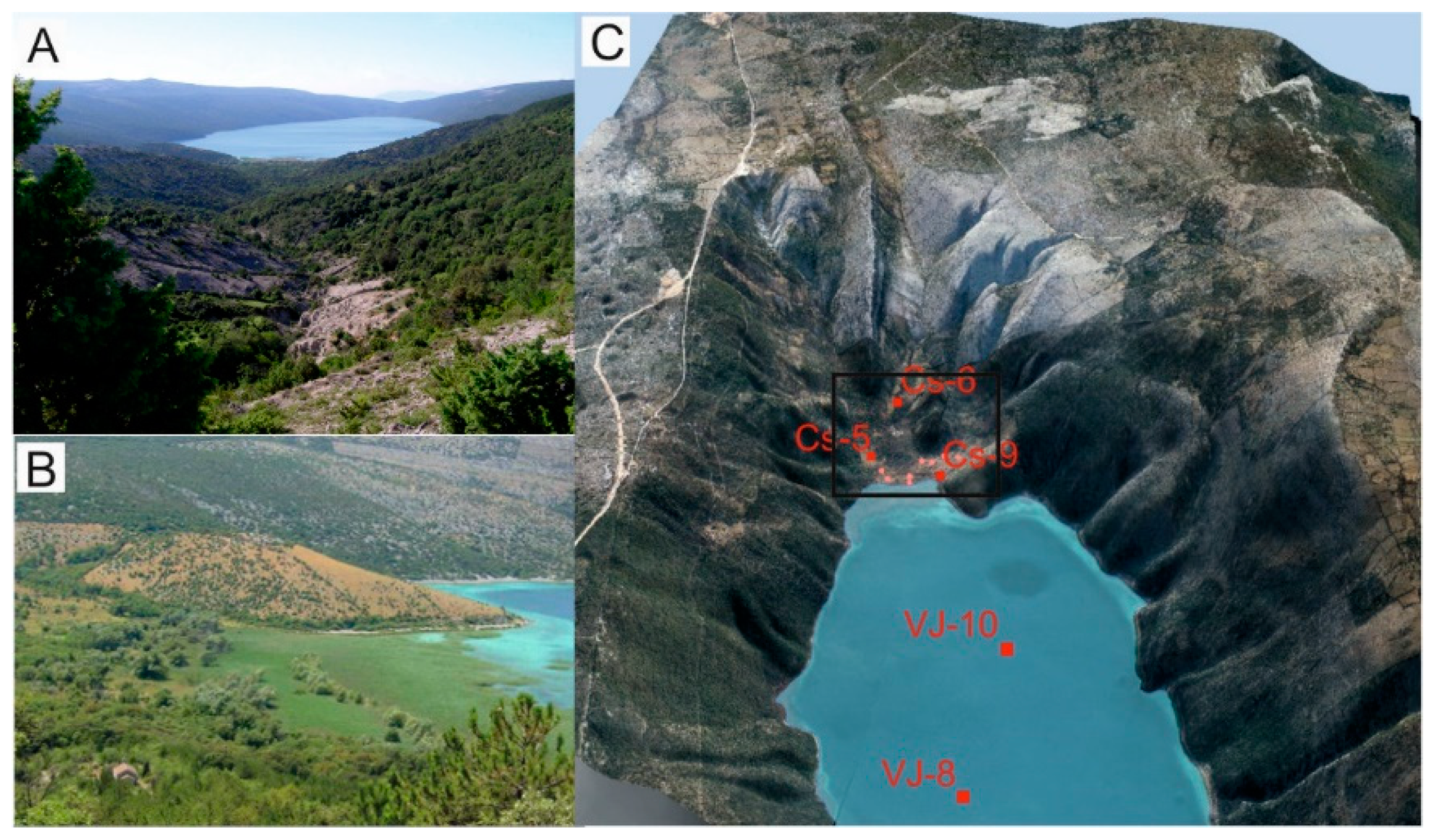
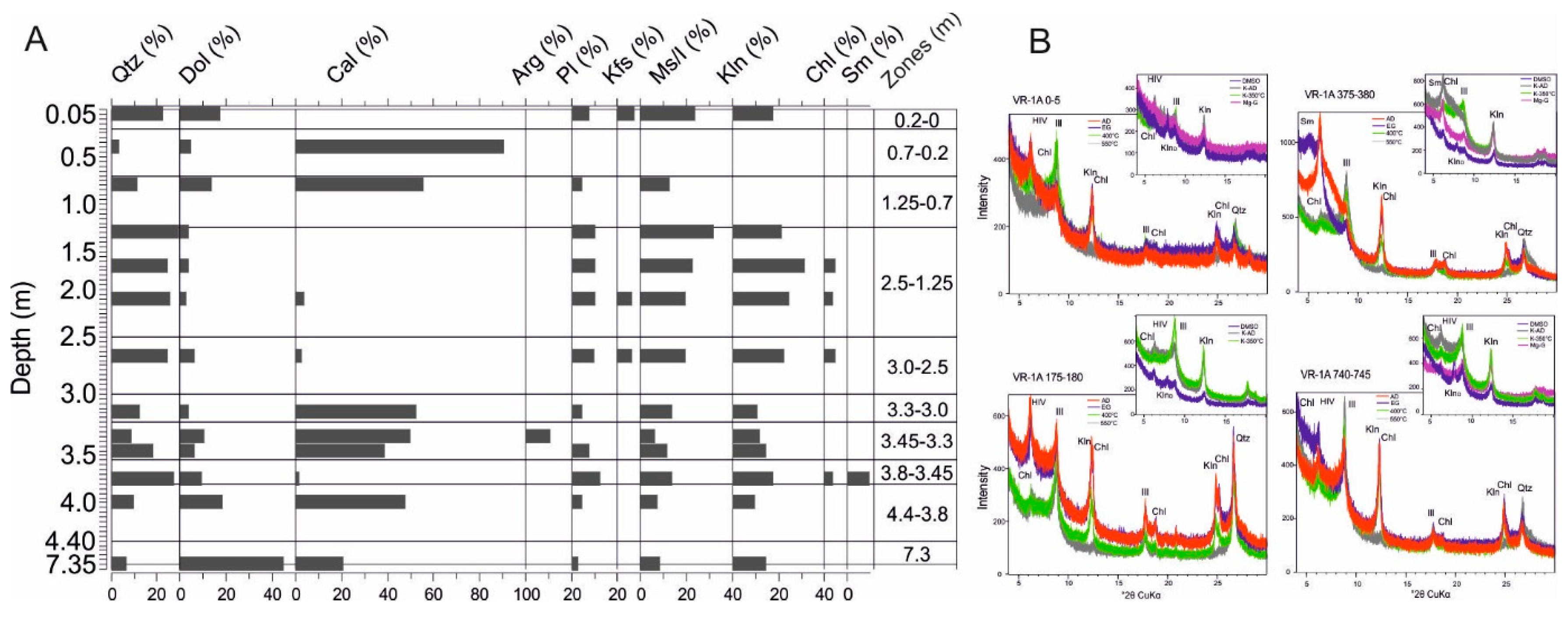
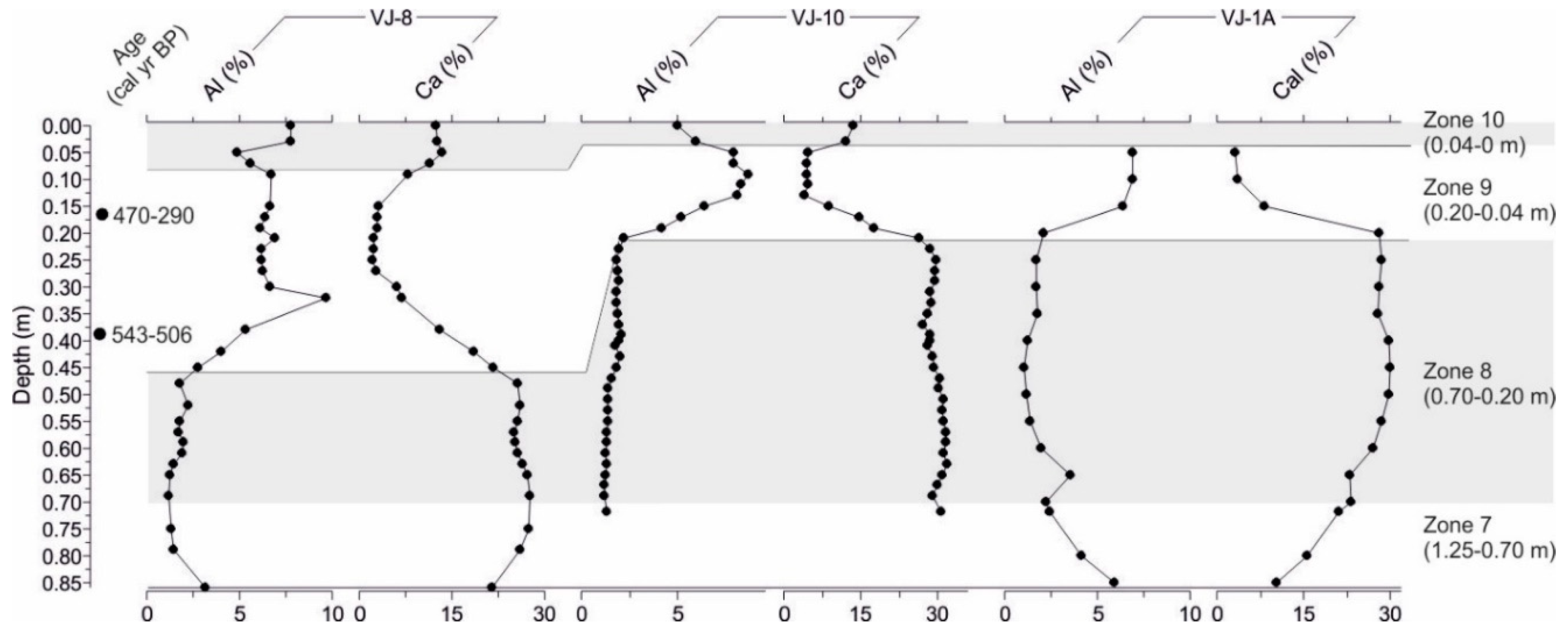
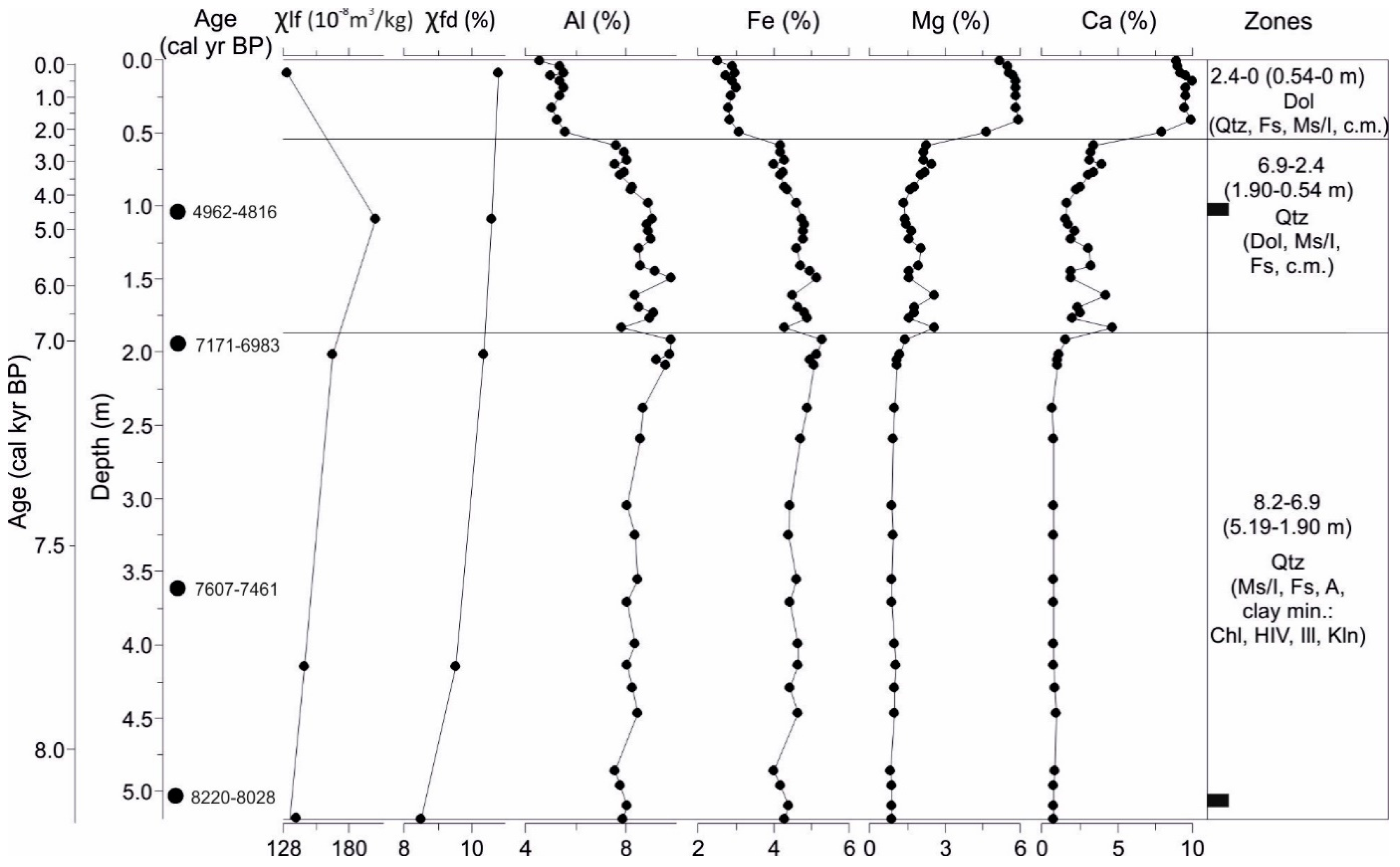
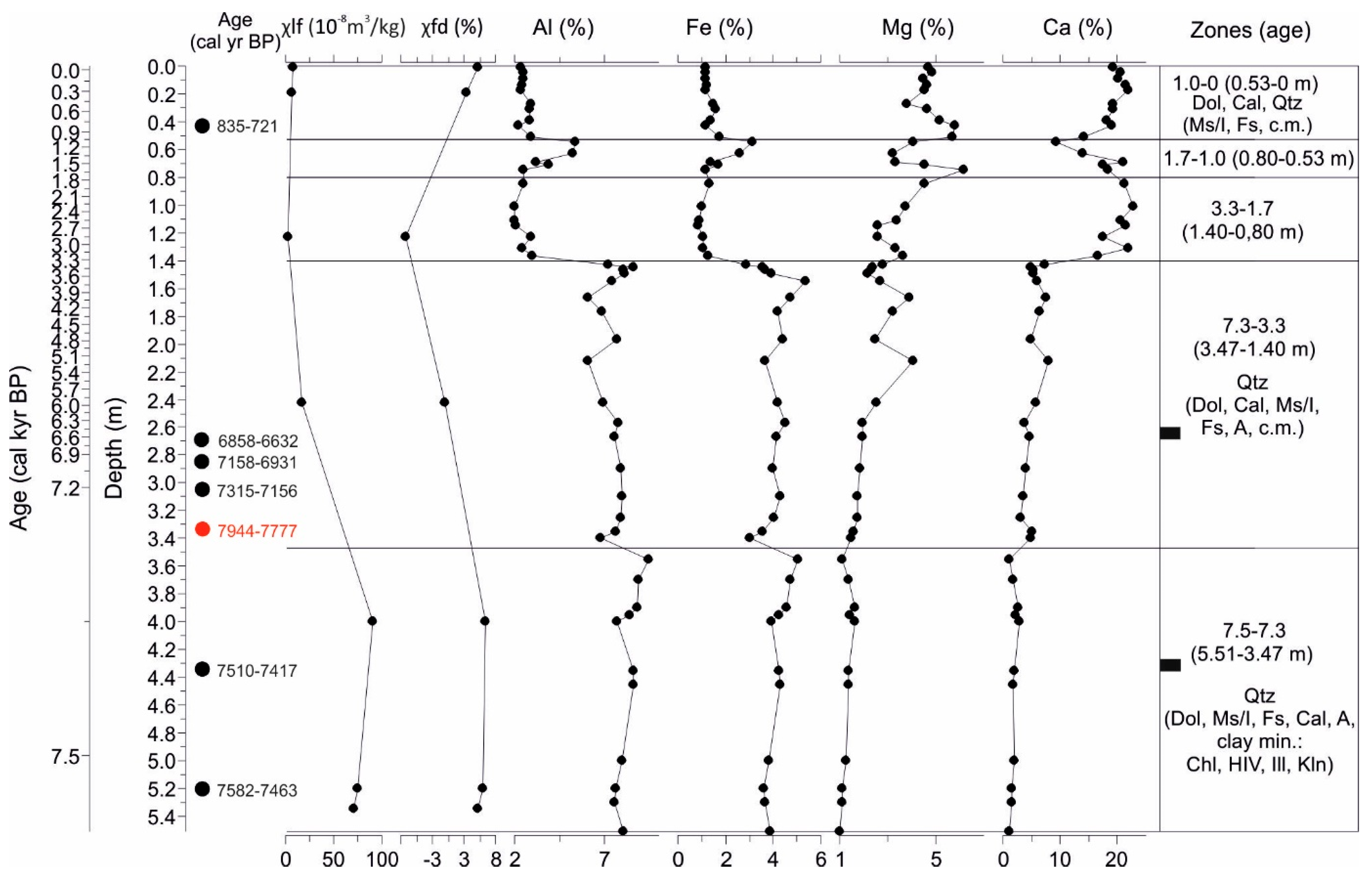
| Core | Depth (cm) | Lab. no. | Material | δ13C (‰) | Radiocarbon age (14C BP) | Calendar age (calibrated) - 95% probability (cal yr BP) |
|---|---|---|---|---|---|---|
| VJ-8 1 | 18 | / | Wood, plant | ND | 300 ± 40 | 470-290 |
| VJ-8 1 | 37 | / | Wood, plant | ND | 500 ± 25 | 543-506 |
| VR-1A | 77-78 | GdA-3300 | Wood, plant | ND | 1870 ± 25 | 1828-1715 |
| VR-1A | 189-190 | GdA-3301 | Wood, plant | ND | 7155 ± 30 | 8019-7933 |
| VR-1A | 317-318 | GdA-3302 | Wood, plant | ND | 10.400 ± 35 | 12.483-12.092 |
| VR-1A | 521-523 | Beta-328265 | Mollusk | -2.5‰ | NA | >43.500 BP |
| VR-1A | 733-735 1 (725-727 cm) | Beta-328266 | Mollusk | -1.2‰ | NA | >43.500 BP |
| CS-5 | 106-110 | Beta-229818 | Charcoal | -25.6 | 4280 ± 40 BP | 4962-4816 |
| CS-5 | 188-198 | Beta-2229819 | Charcoal | -25.7 | 6200 ± 40 BP | 7171-6983 |
| CS-5 | 360-370 | Beta-229823 | Charcoal | -24.9 | 6660 ± 50 BP | 7607-7461 |
| CS-5 | 501-506 | Beta-229824 | Charcoal | -24.6 | 7360 ± 50 BP | 8220-8028 |
| CS-9 | 42-44 | Beta-228408 | Charcoal | -23.3 | 880 ± 40 BP | 835-721 |
| CS-9 | 270-275 | Beta-229820 | Charcoal | -25.6 | 5910 ± 50 BP | 6858-6632 |
| CS-9 | 283-288 | Beta-229821 | Charcoal | -26.2 | 6130 ± 40 BP | 7158-6931 |
| CS-9 | 303-308 | Beta-229822 | Charcoal | -24.8 | 6290 ± 40 BP | 7315-7156 |
| CS-9 | 333-338 | Beta-228414 | Charcoal | -25.3 | 7030 ± 40 BP | 7944-7777 |
| CS-9 | 433-438 | Beta-228415 | Charcoal | -23.3 | 6530 ± 40 BP | 7510-7417 |
| CS-9 | 515-525 | Beta-228416 | Charcoal | -23.3 | 6650 ± 40 BP | 7582-7463 |
| N-4 248-259 2 | 174-176 | Beta-199264 | Charcoal | -24.2 | 3590 ± 40 BP | 3986-3825 |
| CS-P 231 | 231 | GdA-3303 | Wood, plant | ND | 15.390 ± 60 | 18.837-18.630 |
| CS-6 30-35 2 | 270 | Beta-228407 | Charcoal | -23.3 | 24.260 ± 120 | 28.759-28.036 |
Disclaimer/Publisher’s Note: The statements, opinions and data contained in all publications are solely those of the individual author(s) and contributor(s) and not of MDPI and/or the editor(s). MDPI and/or the editor(s) disclaim responsibility for any injury to people or property resulting from any ideas, methods, instructions or products referred to in the content. |
© 2024 by the authors. Licensee MDPI, Basel, Switzerland. This article is an open access article distributed under the terms and conditions of the Creative Commons Attribution (CC BY) license (http://creativecommons.org/licenses/by/4.0/).





